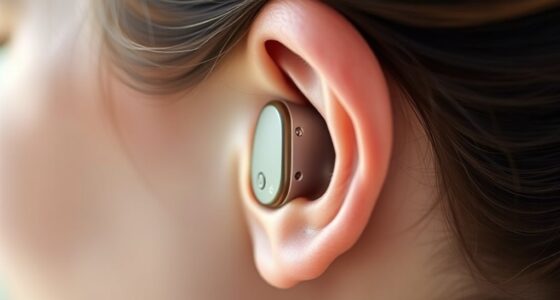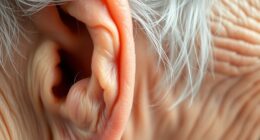In the tech showdown between bone and air conduction, you’ll find that air conduction offers richer, more immersive sound, but can block environmental awareness and cause discomfort over time. Bone conduction, on the other hand, rests on your cheekbones or temples, providing comfort and better situational awareness, especially for hearing health needs. If you want to understand how these differences impact your daily life and preferences, keep exploring their features and benefits.
Key Takeaways
- Air conduction offers richer sound quality with immersive experience, while bone conduction provides clearer environmental awareness.
- Bone conduction bypasses eardrum vibrations, making it suitable for those with ear conditions or needing situational awareness.
- Air conduction devices typically block environmental sounds, whereas bone conduction leaves ears open for safety and alertness.
- Modern bone conduction tech is improving sound fidelity, narrowing the gap with traditional air conduction audio quality.
- Choice depends on user needs: immersive listening versus comfort, safety, or hearing health considerations.

When it comes to hearing, understanding the differences between bone conduction and air conduction is essential, especially if you’re exploring hearing aids or audio devices. These two methods transmit sound in fundamentally different ways, which directly impacts both audio quality and user comfort. Knowing how each works can help you choose the right device for your needs, whether you’re seeking clearer sound or more comfortable wear.
Air conduction is the most familiar approach, where sound travels through the air into your ear canal, vibrating your eardrum and then your inner ear. This process generally delivers high audio quality, with rich bass and clear treble, making it ideal for listening to music, watching videos, or engaging in phone calls. However, air conduction devices, like traditional headphones and earbuds, often sit directly inside or over your ears, which can cause discomfort during prolonged use. They may also block environmental sounds, which might be a safety concern if you’re walking or commuting.
Air conduction provides high-quality sound but can cause discomfort and block environmental awareness.
Bone conduction, on the other hand, bypasses the eardrum entirely. Instead, it transmits sound vibrations directly through the bones of your skull to your inner ear. This method offers a different experience: the audio quality can be surprisingly good, especially with modern technology, but it might lack the depth and richness of air conduction sound. The advantage, however, lies in user comfort. Because bone conduction devices rest on your cheekbones or temples rather than inside your ears, they tend to be more comfortable for extended wear. Plus, they leave your ears open, allowing you to stay aware of your surroundings without removing your headphones—a big plus for outdoor activities or work environments.
The trade-off between these two methods often comes down to what matters most to you. If you prioritize immersive audio quality and are willing to tolerate some discomfort for longer periods, air conduction headphones might suit you better. But if comfort, situational awareness, or hearing aid compatibility are more important, bone conduction devices could be a better choice. Advances in bone conduction technology are steadily improving the audio quality, narrowing the gap with traditional air conduction headphones. Meanwhile, air conduction devices continue to evolve with ergonomic designs that boost user comfort and reduce fatigue.
Another factor to consider is the hearing health of the user, as bone conduction can be a viable option for those with certain ear conditions or damage to the eardrum, making it a valuable alternative for specific needs. Ultimately, your decision should consider your lifestyle, hearing needs, and preferences. Both methods have their strengths and drawbacks, but understanding how they differ helps you make an informed choice that best fits your daily routines and listening habits.
Frequently Asked Questions
Can Bone Conduction Hearing Aids Improve Tinnitus Symptoms?
If you’re wondering whether bone conduction hearing aids can improve tinnitus symptoms, the answer is yes, they often can. These devices provide tinnitus relief by delivering sound directly to your inner ear, bypassing damaged parts of your ear. This hearing enhancement helps mask tinnitus sounds, making them less noticeable. Many users find that bone conduction aids reduce their tinnitus perception, improving overall comfort and quality of life.
How Do Bone Conduction Headphones Impact Long-Term Hearing Health?
Thinking of bone conduction headphones as gentle guardians, you might wonder about their impact on your hearing safety and long-term effects. These devices bypass your eardrum, reducing the risk of damage from loud sounds. However, if you listen at high volumes for extended periods, they could still pose risks. To protect your hearing health long-term, always keep volume levels moderate and take regular breaks.
Are There Compatibility Issues With Bone Conduction Devices and Certain Ear Conditions?
You might wonder if bone conduction devices work well with your ear condition. If you have an ear canal issue or are prone to ear infections, bone conduction headphones usually pose fewer problems since they don’t sit inside your ear canal. However, if your ear infections are active or your ear canal is damaged, consult a doctor first. These devices bypass the ear canal, reducing irritation but always guarantee compatibility with your specific condition.
What Are the Environmental Limitations of Air Conduction Headphones?
Air conduction headphones work well indoors, but environmental limitations affect outdoor usability. You might struggle with background noise, making it hard to hear clearly. Wind, traffic, or crowded places can interfere with sound quality, reducing your listening experience. If you enjoy outdoor activities, consider how these environmental factors could impact your experience, and explore options like noise-canceling features or alternative devices better suited for noisy environments.
How Does Sound Quality Differ Between Bone Conduction and Traditional Headphones?
Ever wonder if sound quality really matters? You notice that bone conduction headphones often offer decent audio fidelity but struggle with deep bass response compared to traditional headphones. While air conduction headphones deliver richer sound and clearer highs, bone conduction prioritizes situational awareness. So, if you crave immersive audio, traditional headphones might suit you better; for casual listening, bone conduction works fine without blocking out your environment.
Conclusion
Ultimately, whether you lean towards bone conduction or air conduction, each offers a unique way to experience sound—like choosing between a gentle breeze and a warm hug. Both technologies have their charms, quietly enhancing your daily life without stealing the spotlight. So, consider what suits your lifestyle best, and embrace the subtle differences. After all, it’s the comfort and connection that truly matter in your personal sound journey.











